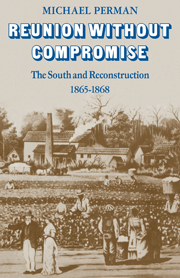Book contents
- Frontmatter
- Contents
- Preface
- Part I Conciliation and conflict
- Introduction: Reconstruction as reconciliation
- 1 Defiant optimism
- Part 2 Encouraging Southern loyalty, 1865
- Part 3 Seeking Southern cooperation, 1866
- Part 4 Demanding Southern acquiescence, 1867–1868
- Epilogue: The irrelevance of the moderates, 1865–1868
- Appendix: Registration and voting statistics for the Southern State Constitutional Conventions, 1867–8
- A note on sources
- Index
Introduction: Reconstruction as reconciliation
Published online by Cambridge University Press: 05 August 2012
- Frontmatter
- Contents
- Preface
- Part I Conciliation and conflict
- Introduction: Reconstruction as reconciliation
- 1 Defiant optimism
- Part 2 Encouraging Southern loyalty, 1865
- Part 3 Seeking Southern cooperation, 1866
- Part 4 Demanding Southern acquiescence, 1867–1868
- Epilogue: The irrelevance of the moderates, 1865–1868
- Appendix: Registration and voting statistics for the Southern State Constitutional Conventions, 1867–8
- A note on sources
- Index
Summary
At the close of the war there was a widespread feeling in the Northern press and among public figures that sensitive and generous treatment of the rebels would be more likely to produce reconciliation and a permanent settlement than harsh measures. Prevalent was the assumption that the Confederates and their allies could undergo a change of attitude and accommodate to the facts of their own defeat and of Northern supremacy. To deny the South's leaders the chance to exercise a desire to conform and manifest their loyal feelings was to allow a great opportunity for reunion to go by default. Since slavery had now been abolished, the argument ran, and the existence of slave labor in the South had after all been the only cause of friction between the sections, there was no major obstacle to reunion. By contrast there were some who doubted that the abolition of slavery had ended all but superficial distinctions. But they also were often sympathetic to the adoption of a conciliatory policy on the grounds that if the sections were fundamentally distinct, coercion and interference in the South would obviously be productive of nothing but tumult and further antagonism. So even those people who believed that despite the cessation of hostilities the sections were still basically out of alignment were amenable to policies which were conciliatory.
- Type
- Chapter
- Information
- Reunion Without CompromiseThe South and Reconstruction: 1865–1868, pp. 3 - 12Publisher: Cambridge University PressPrint publication year: 1973



